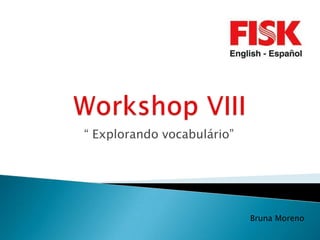
Workshop viii
- 1. “ Explorando vocabulário” Bruna Moreno
- 2. Because each new word has to be studied and learned on its own, the larger your vocabulary becomes, the easier it will be to connect a new word with words you already know, and thus remember its meaning. So your learning speed, or pace, should increase as your vocabulary grows. Johnson O'Connor
- 3. What should we observe when teaching vocabulary?
- 4. When preparing classes and choosing what vocabulary to focus on we should take into account: 1. Frequency: which words and expressions are frequent and which are rare 2. Differences in speaking and writing: which vocabulary is more frequently spoken and which is more frequently written
- 5. 3. Contexts of use: the situations in which people use certain vacabulary 4. Collocation: which words are often used togheter 5. Strategic use of discourse which words and expressions are used to organize and manage discourse
- 6. 6. Polysemy distinguishing between the various meaning of a single word form with several but closely related meanings (head: of a person, of a pin, of an organisation). 7. Homonymy distinguishing between the various meaning of a single word form which has several meanings which are NOT closely related ( e.g. a file: used to put papers in or a tool).
- 7. 8. Homophyny understanding words that have the same pronunciation but different spellings and meanings (e.g. flour, flower) 9. Synonymy distinguishing between the different shades of meaning that synonymous words have (e.g. extend, increase, expand).
- 8. 10. Style, register and dialect Being able to distinguish between different levels of formality, the effect of different contexts and topics, as well as differences in geographical variation. 11. Chunks of language multi-word verbs, idioms, collocations, lexical phrases. 12. Translation awareness of certain differences and similarities between the native and the foreign language (e.g. false cognates).
- 9. Reapeat and recycle Learning vocabulary is related to memory, and usually students need do see, say and write new words many times before they can say they learned it. Provide them chance do review vocabulary
- 10. Complete the chart with languages and countries. Compare your answers with a partner. I can speak... I can’t speak I want to go to... Portuguese Korean Canada A little English (From Touchstone)
- 11. When reviewing or working with lists of vocabulary: Ask students to separate words into a chart: Know it Sort of know it Don’t know it at all Then ask them to write definitions (or my guess on meaning) for the words they know adn sort of know.
- 12. Bingo It can be done in class. Ask your students to choose 9 words from a list and write it in the order they want. Shout the words and when a student has it he / she has to make a sentence. The winner is the one who has all the words and is able to make correct sentences.
- 13. Dictation Auto-dictation It can be assigned as homework. They listen to the cd and write down the words. After that they check the words on the book. If you want, you can ask them to rewrite the words they wrote wrong and hand it to you, so you know what words they are having the most difficulty with.
- 14. Cattegories dictation Create charts with cattegories of vocabulary. As you dictate the words they are supposed to put them in the write cattegory. Furniture Parts of the Means of Parts of the House transportation body
- 15. Word map
